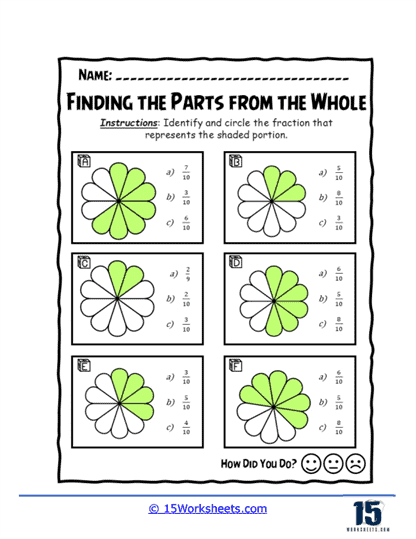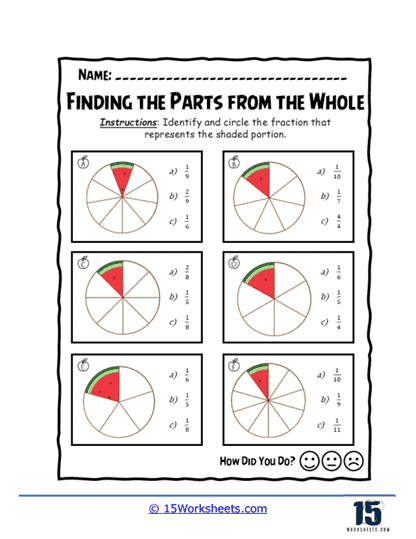Finding the Parts from the Whole Worksheets
All About These 15 Worksheets
These worksheets will help students understand and break down complex mathematical concepts into smaller, more digestible pieces. These worksheets focus on teaching students how to determine parts of a whole by emphasizing relationships between quantities, fractions, percentages, and ratios. They are typically employed in subjects such as mathematics and problem-solving and are instrumental in helping learners enhance their ability to think analytically.
The core concept behind these worksheets is to allow students to take a larger, often more abstract concept-such as a total sum, a full shape, or a complete set-and systematically deconstruct it into identifiable components. This process aids in developing a foundational understanding of how different parts relate to the overall whole. Whether dealing with fractions, percentages, or proportions, students engage in problem-solving exercises that require them to identify the separate components, manipulate them mathematically, and recombine them to either confirm the whole or compare to the original.
Types of Exercises
1. Fraction Decomposition
One of the most common applications of these worksheets is in the realm of fractions. These worksheets often present a whole number or object and ask students to divide it into parts, or fractions. For example, a worksheet might show a circle representing one whole and ask the student to shade or identify a fraction of it, such as 1/4 or 3/8. Additionally, the reverse may be true, where students are given fractions and tasked with reconstructing the whole. This exercise strengthens students’ understanding of how fractions represent parts of a larger unit and how they can be used to express division and proportionality.
Students are also often asked to add or subtract fractions, encouraging them to find common denominators and combine or break apart the fractional parts. These exercises not only enhance their understanding of fractions but also improve their arithmetic skills and precision when working with numbers less than one.
2. Percentage Problems
Another essential aspect of these worksheets involves percentages. Students are provided with a whole number and a percentage and are tasked with finding what part of the whole corresponds to that percentage. For instance, the worksheet may give the problem, “Find 20% of 250,” and the student must apply the appropriate calculation. Conversely, they may be given a percentage and part of a number and need to calculate the whole number from which that percentage was taken. This skill is highly applicable in real-world scenarios, such as calculating discounts, tips, and interest rates. These exercises not only familiarize students with the concept of percentages but also show them how percentages are used in everyday life.
3. Proportions and Ratios
In these worksheets, students are often asked to break down ratios and proportions into parts, reinforcing their understanding of how one quantity relates to another. For example, a worksheet might pose a problem such as, “If the ratio of cats to dogs is 3:4 and there are 12 cats, how many dogs are there?” This type of problem helps students work through proportional reasoning, ensuring they can apply mathematical relationships to find missing parts when some information is given. Proportions and ratios are critical in many areas of mathematics, including geometry, algebra, and even finance.
These problems often encourage students to set up equations to solve for missing values, teaching them how to organize their thinking and approach problem-solving systematically. By practicing with ratios and proportions, students also gain the ability to interpret real-life data, such as map scales, recipe adjustments, or rates of change.
4. Word Problems Involving Parts and Wholes
These worksheets frequently contain word problems that require students to apply their understanding of fractions, percentages, or ratios in a narrative context. For instance, a problem might describe a scenario where a certain percentage of a group of people prefers one activity over another, and students must figure out how many individuals are part of that percentage. Word problems compel students to extract relevant information from a real-world situation and apply mathematical operations to reach a solution.
This type of problem-solving promotes critical thinking as students must often discern which mathematical operations to use and how to interpret the numbers in the context of the problem. It also allows students to connect abstract mathematical concepts to tangible, everyday situations, further solidifying their comprehension.
5. Visual Representations
Another feature often included in these worksheets is the use of visual aids like pie charts, bar graphs, and other geometric shapes that represent wholes. Students may be asked to color in a certain fraction or percentage of a diagram, or they might be required to divide a shape into equal parts. Visual representations help students better understand the concept of parts in relation to the whole, as they can see the division and manipulation of objects right in front of them.
In some exercises, students are provided with charts or graphs that show a portion of the data, and they must calculate the remaining values or reconstruct the entire dataset. This approach helps develop their ability to interpret data, a critical skill in fields such as science, economics, and engineering.
The Real World Applications
These worksheets do not merely serve to build abstract mathematical knowledge; they prepare students for various practical applications in everyday life and future professional fields.
1. Financial Literacy
One of the most immediate real-world applications of the concepts taught in these worksheets is financial literacy. Understanding fractions, percentages, and ratios is vital for managing personal finances. For example, calculating discounts while shopping, determining interest rates on loans, or budgeting monthly income all require the ability to understand how parts relate to a whole. These worksheets equip students with the skills necessary to handle these financial tasks with confidence and accuracy.
2. Cooking and Recipe Adjustments
In cooking, being able to find parts of a whole is essential when adjusting recipes. For example, if a recipe is designed for four people and a person only wants to make enough for two, they must halve the ingredients. This process involves proportional thinking, often requiring the use of fractions or ratios. Practicing with “Finding the Parts from the Whole” worksheets strengthens students’ ability to think proportionally and apply this thinking to tasks such as adjusting recipes, ensuring the correct ratios are maintained even as the quantity changes.
3. Problem-Solving in Professional Contexts
Many professions rely on the ability to break a whole into parts. Engineers, for instance, often use ratios and proportions when designing systems or structures. Financial analysts calculate percentages and fractions when evaluating investments or understanding market trends. Even in healthcare, professionals must sometimes calculate correct dosages based on proportions. By working through these types of worksheets, students develop the analytical skills necessary for solving complex problems in a wide range of professional fields.
4. Data Interpretation
Another real-world application of these worksheets lies in the ability to interpret data. In an age where information is often presented in the form of graphs, charts, and percentages, the ability to understand how parts make up a whole is crucial. Whether analyzing population data, market research, or scientific studies, being able to break down the components of a dataset and understand their relationship to the whole is a valuable skill. These worksheets provide practice in interpreting such data and applying it to draw meaningful conclusions.
5. Time Management and Scheduling
Understanding parts of a whole can also help in managing time effectively. People often need to allocate portions of their day to various activities. For example, if someone has 10 hours of work and needs to spend 30% of that time on a particular project, they must calculate how much time that equates to. Practicing with “Finding the Parts from the Whole” worksheets helps students refine these time management skills, which are vital for productivity in both academic and professional environments.















